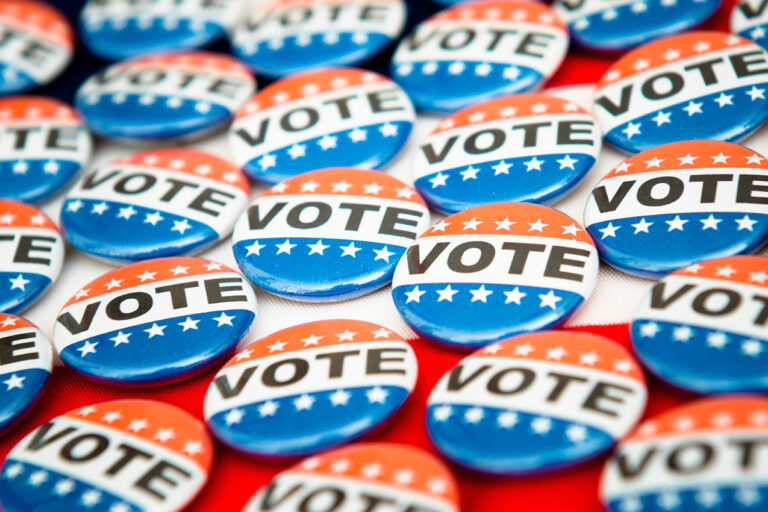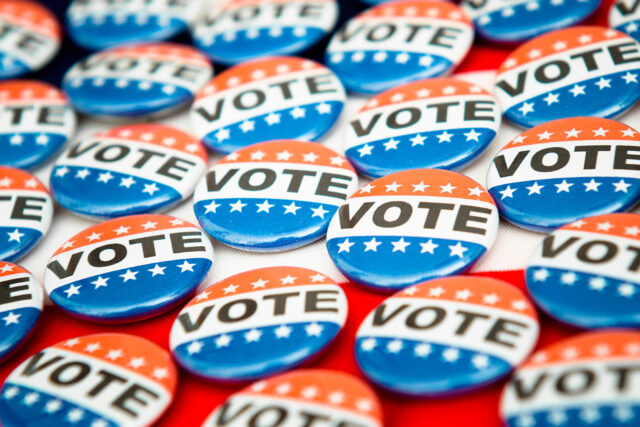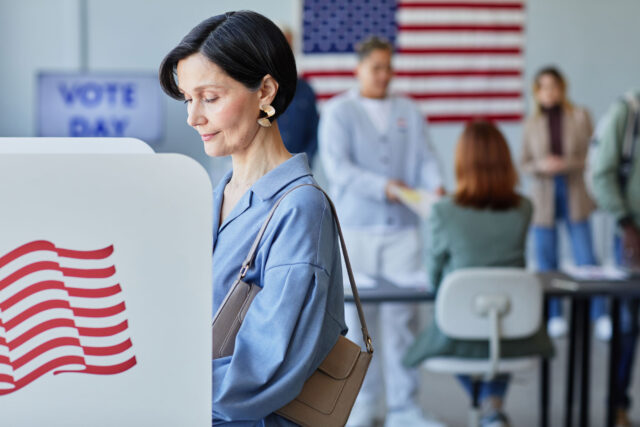Summary
The people who go to the polls in California are very different from those who don’t-a gap that has far-reaching implications for our democracy and political future. The fact that a relatively small, unrepresentative group of Californians elect officials and make policies is an urgent challenge for the state, especially as the population continues to grow and change. While there has been progress in recent years, California still has a long way to go before its electorate reflects the size and diversity of the state as a whole.
- Voters in California tend to be older, white, affluent, college educated, and homeowners. Nonvoters are more likely to be younger, Latino, lower income, less educated, and renters. Voters and nonvoters reflect a growing economic divide-with voters more likely to identify themselves as the “haves” in society, and nonvoters more likely to identify as the “have nots.”
- The economic differences between voters and nonvoters have important implications for policymaking. Compared to voters, nonvoters are more likely to prefer a bigger government with more services. Nonvoters also tend to favor government efforts to combat income inequality and have lower approval ratings of President Trump.
- Although California’s electorate is still disproportionately white, it has become more racially diverse. Whites are currently overrepresented among likely voters, making up 42 percent of adults but 58 percent of likely voters, while Latinos are underrepresented (35% of adults; 19% of likely voters). Asian Americans are slightly underrepresented and African Americans are proportionately represented among likely voters. Since 2006, the share of likely voters who are white has declined 14 percentage points. Meanwhile, the share of likely voters who are Latino grew 5 points and the share of Asian Americans rose 8 points.
- The divide between voters and nonvoters is deep and persistent. California has recently taken steps to encourage voter participation, but research suggests that registration and voting reforms may have a limited effect on increasing turnout among those least likely to go to the polls. Improving civic engagement is critical, and in the wake of the 2016 election, building confidence in elections and trust in government will be paramount. Public and private efforts, including targeted drives to increase civics education, voter registration, and turnout in underrepresented communities, could result in broader representation of Californians’ views.
These efforts will not be easy-there are powerful socioeconomic factors influencing political participation. Broader endeavors to increase economic opportunity, such as policies that produce high-paying jobs, affordable housing, and higher college graduation rates, could also contribute to a larger, more diverse voting population. Millions of California adults are documented and undocumented noncitizens. Efforts are also needed to encourage more noncitizens to become citizens so that they can join the voter rolls. In a state that increasingly relies on the ballot box to make major policy decisions, a more engaged and representative electorate would be a source of long-term stability, helping to create a stronger future for California.
For visual highlights of this research, visit our related interactive. For a discussion of how California’s exclusive electorate could influence the 2020 election and the state’s future, read this blog post by Mark Baldassare.
Introduction
California’s electorate does not reflect the size, growth, or diversity of California’s population. These disparities-while not unique to California-raise real concerns, especially since our state calls on voters not only to elect representatives but also to make policy decisions through ballot initiatives.1
Today, 82 percent of California’s adults are eligible to vote, but only 64 percent are registered to do so. Consistent with prior elections over the last two decades-and despite the highest midterm turnout since 1982-fewer than half of California adults (42%) voted in the 2018 election and 12.5 million eligible adults did not vote. Based on the state’s track record since 2000, about half of all adults in California can be expected to vote in the November 2020 presidential election.
What does this mean for policymaking? Because the number of nonvoting California adults is so large, their attitudes often drive overall public opinion on key issues. Yet voters generally have very different views from nonvoters, and voters’ preferences prevail at the ballot box. The economic divide behind this voting gap has profound implications for the state.
California was a focal point in the 2018 midterm election, and about seven in ten likely voters (69%) reported being more enthusiastic about voting than usual. This level of enthusiasm was greater than in the last presidential election in 2016 (49%) and the last midterm in 2014 (40%).2 The contested congressional districts in the state-many of which were in Southern California-likely played a role in the increased enthusiasm. Given the decision to move up the state’s primary from June to March, California is set to play a prominent role in the selection process for the Democratic presidential nominee. In the last decade, California has taken steps to encourage voter registration and participation-unlike many other parts of the country-and the upcoming election will provide an opportunity to assess the impact of these reforms (McGhee and Romero 2015).
The 2020 Census is also just around the corner. The census, and the potential for an undercount, could have far-reaching effects on Californians, especially nonvoters. For example, undercounting immigrants (including noncitizens), racial/ethnic minorities, and other historically hard-to-count groups would shift political representation away from poorer areas with larger communities of color toward wealthier, predominantly white regions (Thorman, Hayes, and Bohn 2019; Hayes 2019). The communities that are most at risk of losing political representation if there is an undercount are also those that are less likely to vote.
This report shows the trends in political participation from the 2002 gubernatorial election to the 2018 gubernatorial election. We provide details on the demographic and economic profiles-as well as the political and policy preferences-of likely (i.e., frequent) voters, those not registered to vote (i.e., nonvoters, whether eligible or ineligible), and the overall adult population. The facts provided are based on analyses of state data sources and the results from PPIC Statewide Surveys in 2018 and 2019.3
Registration Has Begun to Keep Pace with Population Growth, But Turnout Lags
The vast majority of California adults are eligible to register and vote in elections. Since 2002, more than 80 percent of adults have been eligible to vote, but significantly fewer have been registered to do so and no more than half have turned out at the polls (Figure 1). Notably, on the heels of record low turnout in 2014, the 2018 election saw the highest turnout (42% of adults) for a midterm election in California since 1982.4
Figure 1. Voter eligibility is high, but participation lags behind
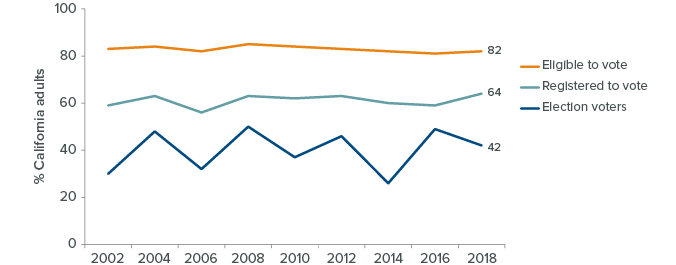
SOURCE: California Secretary of State and Department of Finance.
In 2002, 21.5 million Californians were eligible to vote; today, 25.2 million are (Table 1). The percentage of adults who were eligible to vote in 2018 (82%) is nearly unchanged from 2002 (84%), while registration as a share of eligible adults has increased (71% in 2002; 78% in 2018), according to the California Secretary of State. These trends partly reflect immigration’s ongoing contribution that impact the share of eligible voters, who must be either US born or naturalized citizens.5
Table 1. Political participation by the numbers
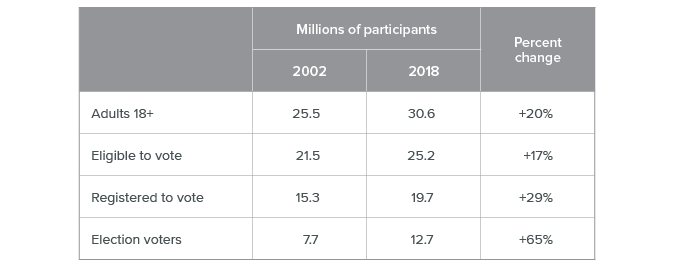
SOURCES: California Secretary of State and Department of Finance.
Growth in voter registration has been strong-and is keeping pace with growth in the adult population. Since 2002, the number of adults age 18 and older in California-the base for registered voters-has increased by 20 percent. During the same period, voter registration has risen even higher, about 29 percent. Much of the registration growth has occurred in the last few years: since 2014, California’s adult population has increased by 4 percent, while registration has risen by 11 percent. Today, 64 percent of adults are registered to vote in California elections, compared to 60 percent in 2002 and 60 percent in 2014. Further, the share of eligible Californians who are registered to vote is higher than at any point in the last 20 years.
However, despite particularly high turnout in 2018, voter participation in California has been low in recent years, especially relative to other states (McGhee and Bonner 2019). Since 2002, an average of 33 percent (ranging from 25% to 42%) of all adults have voted in the five November elections that included the gubernatorial race at the top of the statewide ballot. Presidential elections have had much higher turnouts, with an average of 48 percent (ranging from 46% to 50%) of all adults voting in the last four November elections that included the presidential race at the top of the statewide ballot. However, the California primaries in presidential and gubernatorial years have had much lower turnouts.
Despite Some Progress, Voters Do Not Reflect the State’s Racial Diversity
In a democracy, low political participation is cause for worry in and of itself. It could be a symptom of the public’s feelings of alienation from the political system and distrust in its government and leaders. If a small electorate is not representative of the population-as is the case in California-there is even greater cause for concern.
Analysis of thousands of interviews from the PPIC Statewide Survey shows that California’s likely voters are disproportionately white and US born-though less so than in previous years. California became the first large majority-minority state-with no ethnic or racial group constituting the majority-almost two decades ago in 2000. However, California’s elections have not fully made this demographic transition.
Today, California’s adult population is 42 percent white and 35 percent Latino; the remainder are Asian American (15%), African American (6%), and other (3%). Yet nearly six in ten California likely voters are white, only 19 percent are Latino, and the balance are Asian American, African American, and other. Among nonvoters, nearly six in ten are Latino and only 21 percent are white (Figure 2). Moreover, even though one in three adults are foreign born, 83 percent of Californians who frequently vote in state elections are US born; among nonvoters, only three in ten are US born (California Department of Finance 2019).6
Figure 2. Voters do not represent the state’s racial diversity
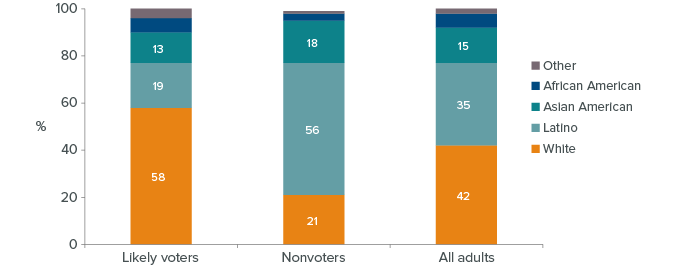
SOURCE: 2018-19 PPIC Statewide Surveys.
The electorate has become more racially diverse since 2006, when we first reported on the exclusive electorate. There has been a decrease of 14 percentage points (72% to 58%) in the share of likely voters who are white since 2006. Meanwhile, the share who are Latino rose 5 points (14% to 19%) and the share who are Asian American increased 8 points (5% to 13%). The shares of likely voters who are African American (6% each) or from other racial/ethnic groups (3% 2006, 4% today) are unchanged.7
Voters and Nonvoters: The Haves and the Have Nots
Likely voters and nonvoters differ significantly in their socioeconomic status (Figure 3). The majority of Californians who vote frequently are age 45 and older (66%), own their home (67%), have either attended (41%) or graduated (41%) college, and have annual household incomes of $60,000 or more (59%). The majority of nonvoters are younger than age 45 (64%) and renters (69%); about one in five are college graduates (18%) and one in four earn $60,000 or more (24%). Overall, California adults fall in between voters and nonvoters on these dimensions (50% age 45 and older, 50% homeowners, 30% college graduates, 43% have annual household incomes of $60,000 or more).8
Figure 3. Voters tend to be more affluent than nonvoters
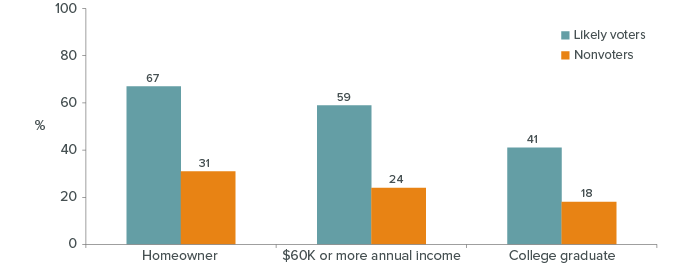
SOURCE: 2018-19 PPIC Statewide Surveys.
The socioeconomic status of likely voters has shifted somewhat since 2006, with likely voters today less likely to be college graduates and homeowners. The share of likely voters who are college graduates has declined 12 percentage points (53% in 2006; 41% today), while the share who are homeowners has declined 10 points (77% in 2006; 67% today). However, likely voters today are just as likely to be 45 and older (62% in 2006; 66% today) and have household incomes of $60,000 or more (56% in 2006; 59% today).
Currently, 67 percent of California adults say that the state is divided into two economic groups, the haves and the have nots. Likely voters (68%) and nonvoters (65%) both hold similar perceptions of living in a two-tier society. But when asked to choose which of the two economic groups they are in, likely voters lean toward identifying with the haves rather than the have nots (50% to 36%), while nonvoters lean toward the have nots rather than the haves (59% to 28%). Nonetheless, half of nonvoters (53%) think that when children today grow up they will be better off financially than their parents, compared to three in ten likely voters (30%) and four in ten adults (40%).9
Voters and Nonvoters See the Political World Differently
Reflecting their different economic conditions-as members of either the haves or the have nots-voters and nonvoters have markedly different political perceptions and attitudes. Because there are so many nonvoters in the state, their attitudes and preferences are often reflected in public opinion on particular issues or topics. However, likely voters’ views prevail at the ballot box on important matters that affect all Californians.
In the following sections, we consider differences between voters and nonvoters on their views of government, fiscal policy perceptions and preferences, and attitudes toward President Trump.
Role of Government
How much government do Californians want? Would they prefer a smaller government providing fewer services or a bigger government providing more services? While about three in four nonvoters (73%) prefer a bigger government, about half of adults (54%) and four in ten likely voters (41%) hold this view. Notably, a majority of likely voters (53%) say they would rather have a smaller government (Figure 4).10
Figure 4. Nonvoters tend to prefer a bigger government and more services
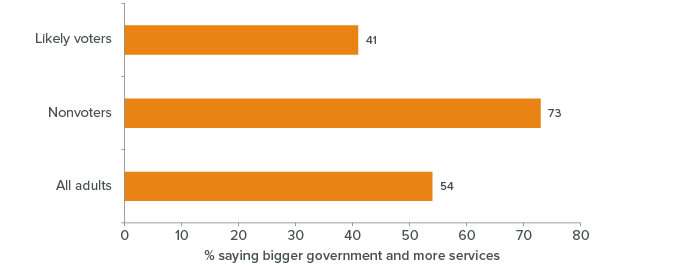
SOURCE: PPIC Statewide Survey, October 2018. “If you had to choose, would you rather have a smaller government providing fewer services, or a bigger government providing more services?”
Differences between likely voters and nonvoters also emerge when it comes to the role of government in dealing with income inequality. Overall, a strong majority of California adults (60%) believe that the government should do more to reduce the gap between the rich and the poor, while one in three (32%) believe that this is not something that the government should be doing (Figure 5). Likely voters are more divided on this issue, with a slim majority in favor of the government doing more (53% to 43%). By contrast, two in three (67%) nonvoters say the government should do more to reduce income inequality, and about one in five say the government should not do more.11
Figure 5. Nonvoters express more support for the government doing more to reduce income inequality
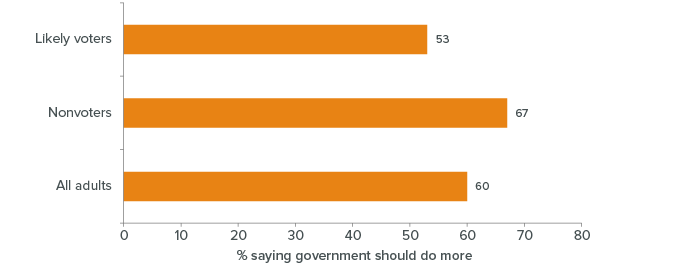
SOURCE: PPIC Statewide Survey, September 2018. “Should the government do more to reduce the gap between the rich and poor in this country, or is this something the government should not be doing?”
Would Californians prefer a more active role for government when it comes to providing opportunities for all people to get ahead-or are they satisfied with a more limited role? A slim majority of California adults (53%) think that government should do more to make sure that all Californians have an equal opportunity to get ahead, while four in ten adults (41%) believe that all people have an opportunity to get ahead in California today. Similar perceptions are held among likely voters (50% should do more; 42% people have equal opportunity) and nonvoters (59% should do more; 38% people have equal opportunity).12
Fiscal Policy Perceptions and Preferences
The differences between likely voters and nonvoters on the preferred size of government can be seen in their views on fiscal policy. Nonvoters tend to be more optimistic about the state budget and more likely to support spending. When asked about the balance between government spending and tax revenues, 45 percent of California adults think the state budget is a big problem, while just 31 percent of nonvoters share this view. By contrast, half of likely voters (50%) think the state budget situation is a big problem (Figure 6).13
Figure 6. Nonvoters are less likely to see the state budget as a big problem
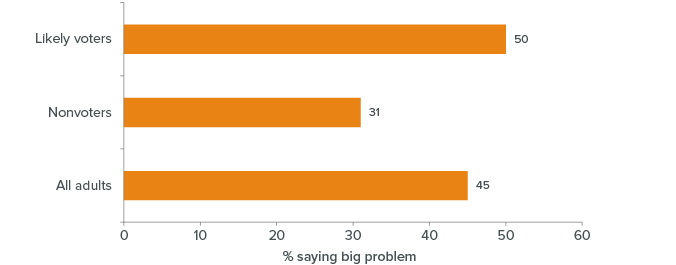
SOURCE: PPIC Statewide Survey, May 2019. “Do you think the state budget situation in California, that is, the balance between government spending and revenues, is a big problem, somewhat of a problem, or not a problem for the people of California today?”
The differing views of likely voters and nonvoters about where to allocate a projected state budget surplus over the next few years clearly reflect the economic conditions of the haves and the have nots. A plurality of likely voters (47%) would prefer to increase state spending on education and health and human services, rather than paying down the debt (28%) or using it for one-time state spending on transportation, water, or infrastructure (18%). Notably, seven in ten nonvoters (71%) would prefer an increase in education and health and human service spending.14
Differences also emerge regarding attitudes toward many of Governor Newsom’s budget proposals. For example, while roughly seven in ten adults (73%) and eight in ten nonvoters (82%) favor allocating about $1 billion to the state’s earned income tax credit to expand eligibility and payments for low-income working individuals and families, just two in three likely voters (65%) are in favor. When asked about $5.3 billion in additional one-time spending to pay down unfunded liabilities in the state and local public employee pension systems, nonvoters (56%) are more likely than all adults (47%) or likely voters (43%) to express support.15
Californians frequently vote on state propositions that determine fiscal and economic policies. There were 16 initiatives in 2018, and there will likely be a number of important ballot measures in 2020. Proposition 51-a $9 billion state bond to fund school construction projects-passed with 55 percent support in 2016. Since all of the funds from Proposition 51 have been either spent or committed, lawmakers are proposing a $15 billion school construction bond for the March 2020 ballot. While majorities of adults, likely voters, and nonvoters would vote yes if a state bond measure to pay for school construction projects were on the ballot, nonvoters (67%) express more support than likely voters (57%) (Figure 7). It is worth noting that nonvoters are more likely than likely voters to have children under age 18 living at home (45% to 29%) and would thus benefit more directly from increased K-12 school funding.16
Figure 7. Nonvoters express more support than voters for a bond measure to pay for school construction projects
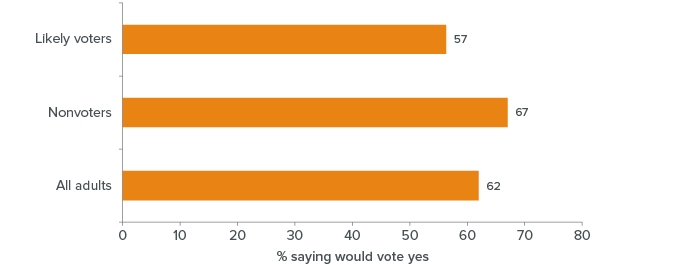
SOURCE: PPIC Statewide Survey, April 2019. “If the state ballot had a bond measure to pay for school construction projects, would you vote yes or no?”
President Trump and the 2020 Election
In 2020, Californians will go to the polls in March to select the party nominees for president and in November to select a president and a large number of federal and state legislators. In a state where the Democratic nominee has not lost a presidential election since 1988 and where Democrats have a 20 point registration advantage, President Trump’s prospects for winning California in November are not great.
However, President Trump could still have a significant impact on the state’s election. In 2016, seven congressional districts in California voted for President Trump, and these districts are the only ones now being represented by a Republican in the wake of the 2018 election. Nonvoters are both more negative about President Trump’s job approval and much more likely to support impeaching the president, compared with likely voters. Thus, an endorsement by President Trump or a candidate supporting impeachment could affect down-ticket races in California’s top-two March primary and in November.
President Trump’s approval rating remains low, with more negativity among nonvoters than among likely voters (Figure 8). Thirty-two percent of all adults approve and 62 percent disapprove of the job he is doing. Among likely voters, the president’s approval ratings are similar (38% approve, 60% disapprove). In contrast, only 24 percent of nonvoters approve (66% disapprove).17
Figure 8. Nonvoters have lower approval ratings of President Trump
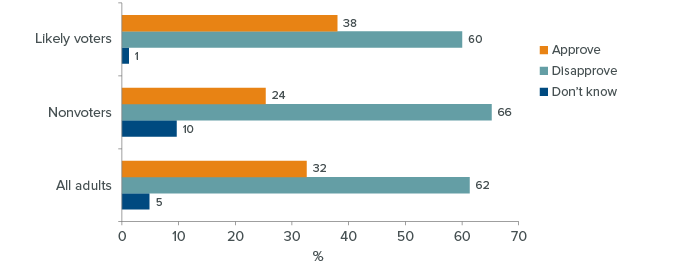
SOURCE: PPIC Statewide Survey, July 2019. “Do you approve or disapprove of the way that Donald Trump is handling his job as president?”
While the decision to impeach President Trump will not be on the ballot, Californians’ views on the subject are likely to affect how they view presidential and congressional candidates running for office. While about half of adults (49%) think Congress should begin impeachment proceedings, there is a 20 point difference between likely voters (42%) and nonvoters (62%).18
Future Consequences and Policy Options
Recently enacted state election laws aim to make it easier for eligible adults to register to vote and for registered voters to cast ballots. In addition to online voter registration, which has been a popular tool since it was enacted prior to the 2012 presidential election, the New Motor Voter Act created a computerized voter registration process for anyone who uses the Department of Motor Vehicles (DMV) to apply for a new driver’s license, renew an old one, or change their address. Enacted in the spring of 2018, this reform has already led to over one million new registered voters who have chosen to register through this system; it has the potential to make registration virtually costless in terms of time and effort (California Secretary of State 2019).
However, previous PPIC research finds that even if reforms succeed in expanding the ranks of likely voters, they may not reach many of those who are least likely to register and vote in the first place. If this is the case, the divide between voters and nonvoters could persist, with voters failing to represent the full range of California’s population (McGhee 2014). Voters and nonvoters would continue to differ greatly in their demographic and economic profiles, fiscal policy perceptions and preferences, and political attitudes-with significant implications for elected representatives and public policy.
Why has the exclusive electorate phenomenon that we identified more than 10 years ago been so slow to change? Civic engagement is a critical factor. When eligible adults are asked why they are not registered to vote, most cite a lack of confidence or a lack of interest in elections, a lack of trust in government, and a lack of time to vote. When registered voters are asked why they do not always vote, their top reasons are also a lack of interest and time, and little confidence and trust. Public and private efforts, including targeted drives to increase civics education, voter registration, and turnout among underrepresented groups (such as Latinos, Asian Americans, low-income residents, renters, and young adults) could result in more diversity in the electorate (Baldassare et al. 2015). More systemic changes like making Election Day a holiday or mandatory voting would also likely increase diversity.
More fundamentally, the broad demographic and economic shifts underway in the state are major factors in reducing the size and nature of the divide between California’s voters and nonvoters today. Immigration is one important element. Millions of California adults are documented and undocumented noncitizens. The share of the adult population that is undocumented is on the decline, but it is still a large segment of California society. Public and private efforts are needed to encourage more noncitizens to become citizens and join the voter rolls. Federal comprehensive immigration reform that provides a path to citizenship is another key ingredient in creating a larger and more diverse electorate.
Gaps in voting participation, demographics, and policy preferences are occurring in the midst of ongoing changes in the 21st century. For example, while whites currently make up the largest share of California’s eligible voters, by 2040 Latinos and whites will make up similar proportions (Citrin and Highton 2002; Romero 2016). Given that California is in the middle of a demographic and economic transition that reflects a combination of powerful forces-including immigration, globalization, information technology, and the aging of the white population-the political effects of these changes will continue for decades.
Conclusions
If trends persist, only half of California adults will vote in the 2020 presidential election-with even fewer participating in the primary-and these voters will not reflect the views of the state’s population. What are the larger consequences of uneven participation rates and low voter turnout?
First, a relatively small group of voters is making decisions about elected representatives and public policy, which raises serious questions about the legitimacy of the democratic system. Next, because the haves in society are the frequent voters, and many of the have nots are not registered to vote or voting, the voting preferences in our elections do not reflect the broad economic and political interests of all adults. Taken together, California once again faces the prospect of an electorate making policy decisions that neglect the realities and problems facing large and growing segments of society.
What might happen if voters were more representative of California’s adult population? Demographic and economic differences result in likely voters and nonvoters who view the political world differently. These differences lead nonvoters to be more supportive of a bigger government that provides more services, to favor government efforts to combat income inequality, and to disapprove of President Trump.
While California still has a long way to go, voters today are much more representative of the state overall. Expanding the electorate even more might inject some optimism into politics, given nonvoters are much more optimistic about the prospects that Americans of different political views can still come together and work out their differences.19 Additional growth and change in the electorate could initially result in more political instability, as elected officials, candidates, parties, and initiative campaigns reach out to a larger and more diverse group of voters (Citrin, Schickler, and Side 2003; Baldassare 2012; Leighley and Nagler 2014). In the long run, however, having a larger and more engaged electorate that is more broadly representative of the people of California would be a source of political stability for a state that increasingly relies on the ballot box to make its major policy decisions.
Topics
Political Landscape Population Statewide Survey

